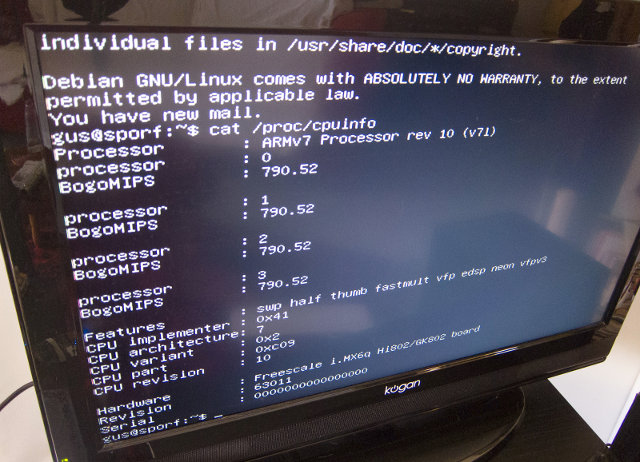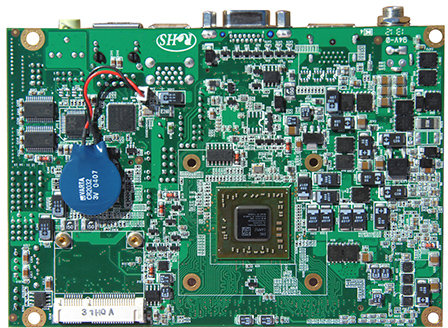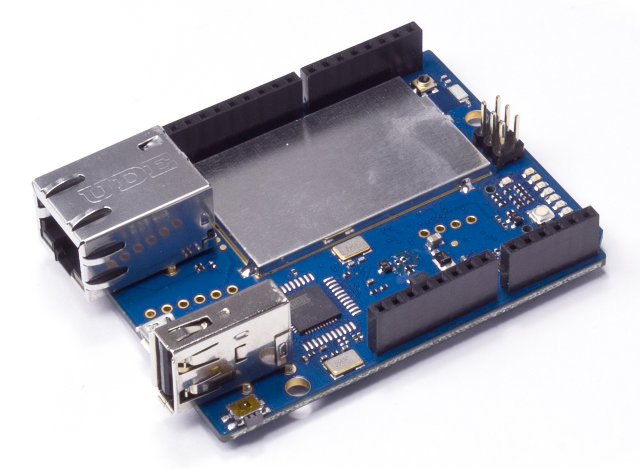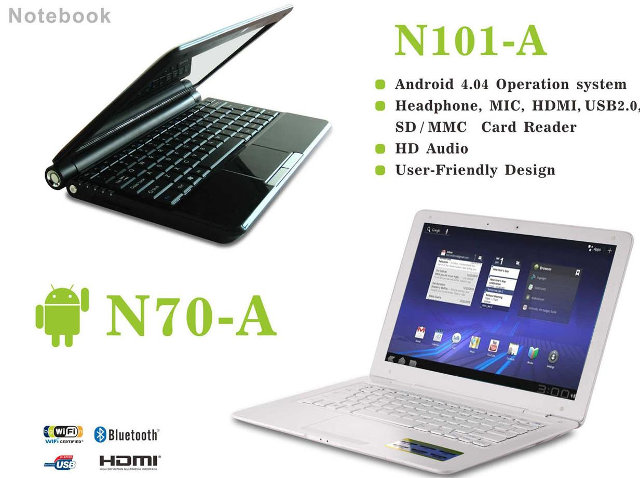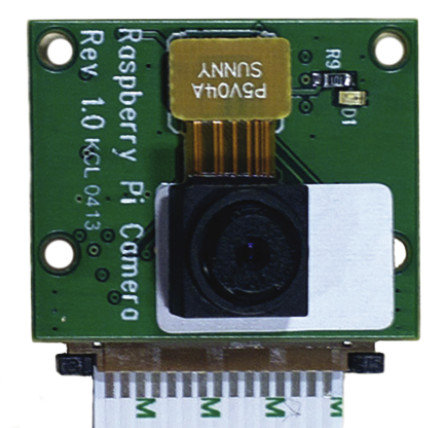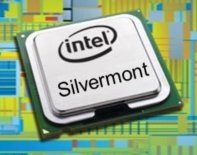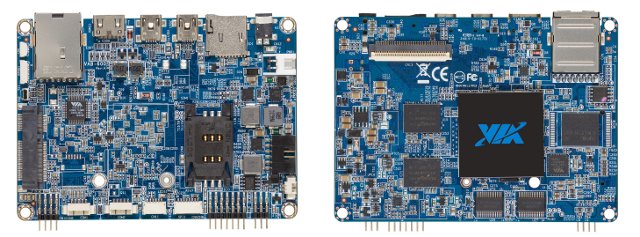We’ve had Ubuntu support on i.MX6 HDMI dongles, specifically HiApad Hi802 and Zealz GK802, for a little while, but for those who prefer Debian distribution, a Debian installer is now available thanks to Angus Gratton. Bear in mind that 2D/3D GPU acceleration is disabled in order to save 192MB RAM, as this image is mainly destined to server and/or robotic applications. If you need a desktop experience with GPU acceleration, you’d have to use Ubuntu, or you may try enable it in Debian, and see if it works, but this has not been tested. The instructions below are to be used with the internal microSD card, but if you’re ready to hack a bit around, it might be possible to run the installer from an external microSD or USB device thanks to Jasbir’s U-boot multiboot. You’d still need to use an internal microSD, but you’d only have to open the […]
Win Enterprises MB-60830 Single Board Computer Powered by AMD Embedded G-Series SoC
At the end of last month, AMD announced their first Embedded SoC family that combines a CPU, a GPU, and a controller hub into one chipset. Win Enterprises is one of the first companies to release a board based on the platform with MB-60830, a single board computer powered by AMD G-Series dual core or quad core SoCs. The board is designed for embedded applications such as digital signage, gaming, medical imaging, kiosks/POS, thin client and factory automation. The board specifications are as follows: SoC – AMD Embedded G-Series SoC dual or quad core. System Memory – 1x DDR3 @ 1600MHZ / SODIMM up to 4GB Storage – 1x SATA 6.0 Gb/s, 1x Half-size Mini-PCIe supporting mSATA for SSD Connectivity – Intel i211 AT Gigabit Ethernet Video Outputs: 1x VGA 1x dual channel 24-bit LVDS 1x HDMI with Optional Chrontel CEC Support Digital I/O – 8-bit programmable LPC – 1x […]
$69 Linux Powered Arduino Yún Board is Designed for the Cloud
Massimo Banzi announced the Arduino Yún, the first of a family of Wi-Fi products combining Arduino with Linux, at the Maker Faire Bay Area. The company used the name Yún (云), meaning “cloud” in Chinese, as the purpose of this board to allow connection to web services directly from Arduino. Arduino Yun Specifications: MCU – Atmel ATMega32u4 @ 16 MHz (same as the one used in Leonardo board) with 2.5KB SRAM and 32KB flash SoC – Atheros AR9331 MIPS-based Wi-Fi SoC running Linino, Arduino’s own Linux distribution based on OpenWRT. It’s the same chipset as in TP-Link WR703N router. Storage – microSD card slot USB – micro USB connector + full USB host port Connectivity – Ethernet + Wi-Fi 14 digital input/output pins (of which 7 can be used as PWM outputs and 12 as analog inputs) Arduino Yún ATMega32u4 can be programmed as a standard Arduino board by plugging it […]
N70-A and N70-B AllWinner A20 and A31 Based Android Netbooks with 13.3″ Display
Last year, H6 Android Netbook featured AllWinner A10 Cortex A8 processor, 1GB RAM, 4GB Flash, and came with a 10.1″ display with 1024×600 resolution, and people who tried did not seem very satisfied with their purchase. This year however, we should get more better hardware thanks to devices like N70-A and N70-B, respectively powered by AllWinner A20 with 1GB RAM, and AllWinner A31 with 2GB RAM, that both come with a 13.3″ display (1280×800). There’s also N101-A model powered by AllWinner A20, but it comes with a 10.1″ display with 1024×600 resolution. All models are available with 8, 16 or 32GB flash, feature Wi-Fi 802.11n and Ethernet connectivity, a 0.3MP front camera, an SD card reader, 2 USB ports, 1 HDMI output, as well as mic IN and headphone jacks. For some reasons, AllWinner A20 models runs Android 4.2.2, but AllWinner A31 still runs Android 4.1.2. You should be able […]
How to Play Games in Android mini PCs / STBs With a PS3 Bluetooth Controller
Android mini PCs ( HDMI TV dongles) are great to make your TV smart, and you may expect to be able to play Android games on your TV easily. The reality is that the keyboard and mouse, or remote controls used with those devices, are not suitable for games, and most games do not play at all. Of course, OUYA and GameStick projects will take care of this, as well as the recently available Project SHIELD ($349) , but if you already have one of those mini PCs, you may not want to spend the money for another device. Luckily there’s a solution, and with some efforts, you can play many games, but not all, with a PS3 Bluetooth controller connected to your Android mini PC or Set-Top Box. I decided to give it a try by buying “GOIGAME Rechargeable Bluetooth Wireless DoubleShock III Controller for PS3” for $16.60, which […]
Raspberry Pi Camera Module Is Now Available, How-to Use It
About one year after showing the first image from the camera module prototype, the Raspberry Pi Foundation announced the Camera board is now available for purchase on RS Component or Element14. Navigating either of these sites is a nightmare, but, if you’re lucky, you should eventually find the camera board for around $25 before taxes and shipping. “Raspicam” features the following hardware specifications: Omnivision 5647 sensor in a fixed-focus module 5MPixel sensor Still picture resolution: 2592 x 1944 Max video resolution: 1080p Max frame rate: 30fps Size: 20 x 25 x 10mm Connection by flat ribbon cable to 15-pin MIPI Camera Serial Interface (CSI) connector S5 on Raspberry Pi computer board The first thing you’ll have to do with the camera is to connect it to the CSI connector on your Raspberry Pi, just behind the Ethernet connector on model B. James explains it very clearly in the video below. […]
Intel Takes on ARM with Silvermont Microarchitecture for Low Power SoCs
Intel has launched Silvermont, a new microarchitecture for low power SoC targeting smartphones, tablets, and servers in data centers. Silvermont SoC will be manufactured using 22nm Tri-Gate SoC process, and the company claims 3x times more peak performance than current generation Atom processors, or 5 times less power consumption at the same performance level. Silvermont will be used in Bay Trail, Avoton, and Merrifield processors: Intel’s quad-core “Bay Trail” SoC is scheduled for Q4 2013 tablets, and variants of the “Bay Trail” platform will also be used in market segments including entry laptop and desktop computers. Intel’s “Merrifield” is scheduled to ship to customers by the end of this year, and actual smartphones will show up in 2014. Intel’s “Avoton” will be used in low power microservers, and provide full server product capability that customers require including 64-bit, integrated fabric, error code correction, Intel virtualization technologies and software compatibility. Intel […]
VIA Unveils VAB-600 Pico-ITX Board Powered by WM8950 Processor
VIA Technologies has recently announced the VAB-600 Pico-ITX embedded board featuring WonderMedia WM8950 ARM Cortex A9 SoC clocked at 800MHz. VIA targets in-vehicle infotainment as well as mobile and healthcare applications for the board despite an operating temperature range between 0°C and 60°C. Here are the key features of this embedded board: SoC – Wondermedia WM8950 Cortex-A9 @ 800MHz + Mali-400 GPU System Memory – 1GB DDR3 SDRAM Storage – 4GB eMMC Flash memory + 512KB SPI Flash for Boot Loader + microSD slot Video Output – Mini HDMI, on-board DVO (Digital Video Output) for TTL or LVDS display Video Codecs – MPEG2 MP@HL, MPEG4, H.264 BP/MP/HP@L4.0, VC-1 SP/MP/AP, VP8 and JPEG/MJPEG. USB – 2x mini USB 2.0 host ports Connectivity – 10/100M Ethernet (VT6113), 3G (SIM card slot) and optional WiFi support (VIA VNT9271B6050 WiFi module shared with one USB port) On-board Connectors: 2x COM connectors 1x RTC battery […]


